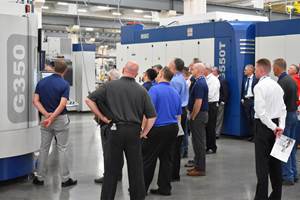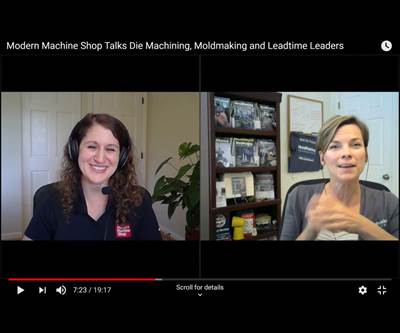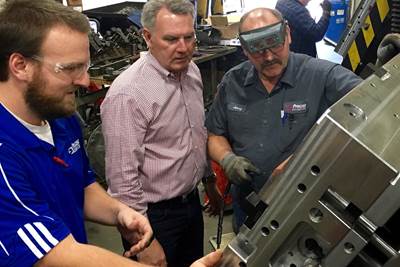Share





.png;maxWidth=45)
DMG MORI - Cincinnati
Featured Content
View More

Takumi USA
Featured Content
View More
Hwacheon Machinery America, Inc.
Featured Content
View MoreAny serious commitment to reshoring manufacturing has to begin with die and mold tooling. For much of production-scale manufacturing of metal and plastic parts, the die or mold is the essential starting point, and the die or mold contains much of the innovation related to both product design and the manufacturing process.
Modern Machine Shop filmed the panel discussion above to bring attention to this important issue. I was the moderator. My panelists included Bill Berry, president of Michigan die and moldmaker Die-Tech and Engineering; Don Dumoulin, CEO of Indiana moldmaker Precise Tooling Solutions; Steve Kline, chief data officer with Gardner Intelligence; and Harry Moser, founder of The Reshoring Initiative.
Related Resources:
- Die-Tech & Engineering's rapid response in tooling needed for ventilator parts
- Die-Tech & Engineering's system for producing tooling with short lead times (2010 article, but still fundamentally the system the company uses)
- Precise Tooling Solutions on the impact of mold tariffs
- Precise Tooling Solutions is MoldMaking Technology's 2020 Leadtime Leader
- Reshoring Initiative on supply chain lessons from COVID-19 (first of a series of 4 webinars)
- Gardner Intelligence blog
Watch the video above for the full discussion. Here is a partial transcript:
Peter Zelinski
Bill Berry, your company manufactures tooling. We've seen tooling work sent overseas, particularly to China, in search of lower cost. When did that begin? And why?
Bill Berry, Die-Tech and Engineering
It’s very difficult for me to identify exactly when that began, but I was in international service for General Motors in the late ‘80s. The automotive companies started exploring producing their products overseas then, and they were exposed to dramatic savings in tooling that low-cost countries could provide. I think, short-sightedly, they felt that nothing was given away by just buying low-cost tooling, foregoing all the knowledge that is built into the tool when you work closely with a tooling supplier.
Peter Zelinski
Bill said, “short-sightedly.” Harry Moser, we're going to explore the economics of this later in the discussion, but from a higher-level view, how is the manufacturer who buys and uses tooling potentially hurt by sending tooling work far away? How is the nation as a whole hurt by that if our tool and die capacity declines?
Harry Moser, The Reshoring Initiative
I'll start by building on what Bill said: When the tooling is done offshore, there is a different language, a different time zone and no chance to meet face to face. The partnership between the tooling buyer and the tooling producer is largely reduced. It's critical to be able to optimize the product and the process by working in parallel rather than separating the tooling buyer and producer by such great distances that this is impossible. Then, there is delivery. If it’s a big tool, it’s either a very long time to ship by boat, or else there's airfreight. Add in tariffs, if they apply, and intellectual property risk — all these things can be substantial for the manufacturer. In terms of the nation, there is the trade deficit as well as military preparedness. If you don't have the tools now to make the consumer product, you won’t have the tools and tooling capacity to make the tanks.
Peter Zelinski
Steve Kline, can you give us a big picture that fleshes that out? Tool and die is a relatively small sector, but it controls much larger sectors. Molded plastic parts need tooling, die-cast parts need tooling, stamped parts need tooling. Can you give us a sense of this? What's the size of the U.S. tool and die market, and by comparison, what is the size of injection molding, die casting and stamping?
Steve Kline, Gardner Intelligence
The best place to start is production of dies and molds. Since 2011 or so, after the Great Recession, the die/mold market in the U.S. has been about $6 billion on average. Now, that production figure does not include dies and molds produced in house by OEMs, so we're really only talking about dies and molds produced by companies like Bill’s and Don’s. Then, we want to add into that imports and exports. Since 1989, die and mold imports have been on a steady increase into the U.S., while exports have remained relatively the same. If we add imports to production and subtract out exports, we get consumption of dies and molds in the U.S. For the last three years, we've been right around $8 billion, which is an all-time high for die and mold consumption in the United States. But to your point, Pete, if we put that into context of where dies and molds are used, if we look at custom plastic processors, which are essentially contract injection molders, those companies ship about $100 billion of plastic parts per year. So molders alone account for more than 10 times the size of the die/mold market. When we're using dies and molds, they account for less than 10% of the market they're being used in.
Peter Zelinski
Don, why is tooling expensive? Say “tool” to the average person, and they think of a hammer or screwdriver. Your company's molds are tools, but they're way more specialized and sophisticated than what we associate with that word. What goes into making an injection mold for a plastic part?
Don Dumoulin, Precise Tooling Solutions
That's a great question. Our molds sell for somewhere between $100,000 and $150,000. They weigh somewhere between four and six tons, and we'll have some 2,000 hours of design and then manufacturing that goes into building each of them. They're all high-caliber steel with very complicated movements in them. If you think about any plastic part that you see in your car or in your daily life, and you try to imagine that coming out of two big blocks of steel, you’ll realize why there are a lot of moving parts: because when that mold pulls apart, there are slides and lifters and other elements that help release that plastic part. So, these tools are really complicated, and they take skilled craftsmen to build them.
Peter Zelinski
Harry, react to what Don described. When manufacturers seek a lower price for their tooling from an overseas supplier, is that price really a savings? How should we think about cost?
Harry Moser, The Reshoring Initiative
It can be a savings, and it probably was a savings 20 years ago when Chinese labor cost was so low. However, the main issue is the way companies look only at that price, or the wage rate, and not what we call the “total cost of ownership.” When you add in all the other factors, duty-free carrying cost of inventory plus quality differences and so on, you get an entirely different picture. We've charted the price from China as a percentage of the U.S. price on hundreds of samples of different products. When companies look only at price, the U.S. wins 8% of the time, when they look at total cost, we win 32% of the time, and when they look at total cost plus the effect of a tariff such as the the recent tariffs on tooling, the U.S. wins 46% of the time. So, by doing the math correctly — by looking at all the relevant factors — the U.S. is in a much stronger position.
Bill Berry, Die-Tech and Engineering
Could I comment on that? The question was: Is that price really a savings? We've seen time and again, many tooling buyers don’t really have a good handle on their total cost to produce parts. If you look at the line item for tooling costs, invariably, the tooling cost would be higher if the tool was acquired here. However, along with that tooling, we are often able to supply ideas and changes to the manufacturing processes that greatly reduce the cost to produce the part. We had an example a few years ago in which almost the entire cost of an office furniture manufacturer’s tooling program was recouped in operational savings through the way we were able to work with them to eliminate some assembly operations and some components in one of their products. We could only do that because we had knowledge of their operations, and instead of just producing the tool, they asked us to suggest changes to their design that reduced the cost to source the parts. When you go offshore for tooling, you send out a print. There are language barriers, and the company that's quoting probably knows nothing of your operations. You get a price. The company gives you the price you asked for. They don’t give you ideas that might improve your operational efficiencies. I think that's something the entire cost accounting system in United States manufacturing doesn't do a good job of understanding.
Related Content
Lyndex-Nikken Collets Enable Accurate Small-Diameter Cutting
The MMC Mini-Mini collet chuck is well suited for high-speed machining applications where clearance is needed, such as die mold, aerospace and medical parts.
Read MoreHow to Achieve Unmatched Accuracy in Very Large Workpieces
Dynamic Tool Corp. purchases two bridge-style double-column CNCs to increase the cutting envelope and maintain 5-micron cutting accuracy in the long term.
Read MoreIn Moldmaking, Mantle Process Addresses Lead Time and Talent Pool
A new process delivered through what looks like a standard machining center promises to streamline machining of injection mold cores and cavities and even answer the declining availability of toolmakers.
Read MoreGrob Systems Inc. to Host Tech Event With Industry Partners
The 5-Axis Live technology event will highlight new machining strategies for optimizing the production of complex medical, aerospace and mold/die parts.
Read MoreRead Next
Modern Machine Shop Talks Die Machining, Moldmaking and Leadtime Leaders
Emily Probst, senior editor of Modern Machine Shop magazine talks with Christina Fuges, executive director of MoldMaking Technology magazine, about 2020 Leadtime Leader Award winner Precise Tooling Solutions and the lessons this moldmaker can teach CNC machine shops.
Read MoreBecause of the Tariff on Mold Tooling, This Indiana Mold Shop’s Business is Now Booming
U.S. molders are now buying their tooling from U.S. mold builders. Precise Tooling Solutions illustrates this, and its owner makes the case for why the tariff matters.
Read MoreDie Maker Describes Five-Day Build for Tool Urgently Needed for Coronavirus Ventilator Production
Running 11 five-axis machines simultaneously, a die maker reduced a five week lead time to just five days. Here’s how.
Read More




































.png;maxWidth=300;quality=90)








